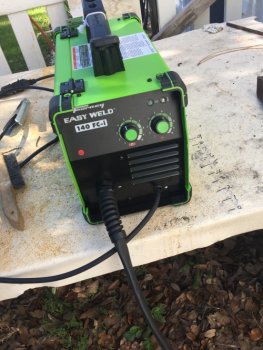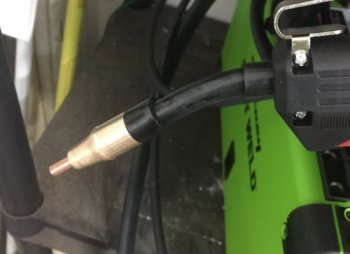I did it! Been wanting and talking about a mig welder for a good while, but couldn't convince myself to turn loose of the money. I've been using an old Lincoln industrial 250 amp, AC/DC welder for the last few years.

My Dad purchased that old welder used more than 50 yrs ago. I've rebuilt the diode bridge more times than I can count over the years. It's a good welder, but for small welds, especially seal welds on San Mai billets I wanted a mig welder. Talking with Joe Cross & reading reviews convinced me to order the Forney Easy Weld 140 which is mig only. I didn't need the model with the arc welding and TIG ability. I've got a perfectly good arc welder, and the cost of argon tank and associated equip isn't worth it for me. I got this one:

I have been very impressed with how well it welds. The big concern I had was 120 vac only. Just seems a welder needs 240 vac. Well, 120 vac does just fine for lower amp use. Forney says it will weld 1/4" thick metal just fine, and thicker if using more than a single pass.
My experience (very limited) is it will weld all I need just fine. I've welded 3/16" and didn't have it max'd out and just fine. Mig is surely different than stick and I'm having to learn - but learning is going MUCH faster than learning stick welding. I can already lay a decent bead. So far, I think I'm pleased with the welder and glad I ordered. Only $230 shipped, but for some reason it cost me almost $300 {g}. That comes from ordering welding wire, extra tips, etc. I'll be ordering welding wire in 10 lb rolls, less expensive that way. About $3/lb vs $7/lb.
Later

My Dad purchased that old welder used more than 50 yrs ago. I've rebuilt the diode bridge more times than I can count over the years. It's a good welder, but for small welds, especially seal welds on San Mai billets I wanted a mig welder. Talking with Joe Cross & reading reviews convinced me to order the Forney Easy Weld 140 which is mig only. I didn't need the model with the arc welding and TIG ability. I've got a perfectly good arc welder, and the cost of argon tank and associated equip isn't worth it for me. I got this one:

I have been very impressed with how well it welds. The big concern I had was 120 vac only. Just seems a welder needs 240 vac. Well, 120 vac does just fine for lower amp use. Forney says it will weld 1/4" thick metal just fine, and thicker if using more than a single pass.
My experience (very limited) is it will weld all I need just fine. I've welded 3/16" and didn't have it max'd out and just fine. Mig is surely different than stick and I'm having to learn - but learning is going MUCH faster than learning stick welding. I can already lay a decent bead. So far, I think I'm pleased with the welder and glad I ordered. Only $230 shipped, but for some reason it cost me almost $300 {g}. That comes from ordering welding wire, extra tips, etc. I'll be ordering welding wire in 10 lb rolls, less expensive that way. About $3/lb vs $7/lb.
Later
Last edited:

